Cooperative biometrics abnormality detection system (C-BAD)
a biometric and abnormality detection technology, applied in the field of biometrics, contactless tags and sensors, can solve the problems of increasing the difficulty of penetration into the system, irrefutable evidence for use in investigation,
- Summary
- Abstract
- Description
- Claims
- Application Information
AI Technical Summary
Benefits of technology
Problems solved by technology
Method used
Image
Examples
Embodiment Construction
[0076] The heart of the Cooperative Biometrics Abnormality Detection (C-BAD) is the Central Processing Unit C-BAD CPU 1. The CPU 1 is connected through a communication network 2 to each major sensor subsystem. These subsystems consist of a Physical Access Sensor network 3, Information Access Sensor network 4, Communication Access Sensor network 5, External Personnel Events database 6, and External Personnel Relationship database 7. The data provided from these sensors, databases, and external sources (are) is analyzed in the CPU 1 and notifies an investigative team 40 or senior management over a communications link 41 when abnormalities are detected.
[0077] Description--FIG. 2
[0078] The C-BAD CPU 1 is a computer system that is rule-based or artificial intelligence or inference engine-based consisting of various logic models that provide the rules of abnormality and normality. The CPU 1 also contains a recording and documenting system (archiving system) 46 that archives all sensor inp...
PUM
 Login to View More
Login to View More Abstract
Description
Claims
Application Information
 Login to View More
Login to View More - R&D
- Intellectual Property
- Life Sciences
- Materials
- Tech Scout
- Unparalleled Data Quality
- Higher Quality Content
- 60% Fewer Hallucinations
Browse by: Latest US Patents, China's latest patents, Technical Efficacy Thesaurus, Application Domain, Technology Topic, Popular Technical Reports.
© 2025 PatSnap. All rights reserved.Legal|Privacy policy|Modern Slavery Act Transparency Statement|Sitemap|About US| Contact US: help@patsnap.com



